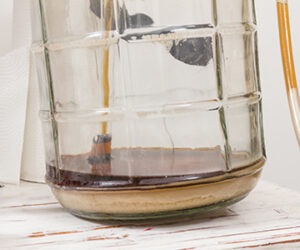Reusing Yeast
The cost of yeast makes up a large chunk of the ingredient expense if you buy a new pitch every batch. Almost every pro brewer reduces that cost by harvesting the yeast after fermentation and reusing it in the next batch (and on and on). Three pros share their advice on harvesting, storing, repitching, and knowing when to call it quits because it’s an area many homebrewers overlook, to the detriment of their budget.

Will Rutemeyer (left) is the Founder of Balter Beerworks in Knoxville, Tennessee and Jake Giganti (right) is the Head Brewer at Balter.
We keep a house ale and house lager yeast going all the time. We will occasionally juggle a couple generations with a third, but it’s too much to keep that going with our small operation.
We see better performance after one or two generations with both strains. Both strains may have slight over or under attenuations on the fresh pitches, and maybe slightly different settling times after fining.
Our usual process for harvesting is to wait for the fermentation to complete, step the temperature down to 34 °F (1 °C) over two days, and harvest into a modified Sanke keg after 24 hours at 34 °F (1 °C). We tag the keg with strain, generation, harvest date, and which batch number and brand it came from. Then we do a yeast count just before pitching. We have found that our lager yeast usually harvests a bit better if we let it sit on a bit of pressure (~5 PSI) for a day or two.
We’ve gone up near 30 generations in the past, but we typically see about 15–20 generations for our ale yeast and 8–12 from our lager strain. We are a 7-barrel brewpub with six fermenters, so we might brew 15 different ales and 5 different lagers with the same yeast before we end up needing a fresh pitch.
We get 2–3 pitches from a single harvest of our ales, so we can usually pick the best next harvest based on the brand and timing. Most of our beers are under 7% ABV, so it’s more about timing the harvest to get the freshest yeast for our next brews. If we happen to need to harvest off our IPA, we’ll do a soft drop to about 60 °F (16 °C), take the yeast, then add our dry hop load.
We take daily pH and gravity readings on all of our active fermentations, so we are looking for any abnormal behavior — Did the pH drop as expected in the first 24 hours? Are the terminal pH and gravity within spec? Did the gravity drop curve look normal? And of course, how does the finished beer smell and taste? If any of these are out of line then we don’t harvest yeast from that batch. We do a methylene blue stain and hemocytometer count within a day or so of brewing. It takes about 20–30 minutes and we use it primarily for targeting our pitch rate. Most of the time, we end up deciding to order a fresh pitch based on fermentation performance, not because we are seeing very low viabilities in the microscope.
Ideally, we’d be using the yeast almost immediately after harvesting, but then there’s the reality of managing the brew schedule. Occasionally, those things align! We have (reluctantly) used yeast up to about 12 days in storage. In that case, we resample and recount the yeast under the microscope and make sure viability hasn’t tanked. But with our brew schedule we are usually looking at less than a week in storage. Our cooler sits about 34–35 °F (~1–2 °C) and we relieve the pressure built up on the yeast a few times a day. Even that’s not ideal, but we’re happy with the beer and happy with our generation count. Or, happy enough — it can always be better!
My advice for homebrewers on the subject is if you’re not already reusing yeast, give it a shot! When we started, we were harvesting into buckets and pitching by a guesstimate of density and volume. And the beer was still decent! Maybe if you save a few bucks on yeast, you can finally justify that next brewing gadget you’ve had your eye on.

Nick Tedeschi is the Head Brewer at The Post Brewing Company in Lafayette, Colorado.
We use two different strains on a regular basis: A house ale strain and a house lager strain. We have been able to get both strains up to 20 generations. With good practices for harvesting, storing, and re-pitching the yeast, we don’t see many differences between generations from a fermentation standpoint. Over time, cell counts do tend to decrease, and cell viability decreases as well. When these get too low we start with a new pitch.
Checking gravity and pH every day of active fermentation and collecting that data allows us to predict how the yeast should perform if the proper amount is pitched. Before repitching, a cell count and viability count is performed, which tells us how much we need to pitch into the next batch. We also plate multiple samples of each beer on growth media to ensure there is no infection of bacteria or wild yeast.
We have been able to find success harvesting and repitching from most beer styles. The exception is we do not harvest yeast that has just fermented a sour beer.
We harvest yeast once fermentation hits terminal gravity, and ideally not a day later. Sitting at terminal gravity will result in lower viability and cell health. We have converted 15.5-gallon (59-L) kegs into fully Clean-In-Place (CIP) yeast brinks, so on a harvest day they are cleaned and sanitized before receiving yeast from the bottom of the fermentation vessel. A cell count and viability count are performed on the day it is harvested, as well as the day it is repitched. After harvest, if the yeast is not being pitched within 48 hours, it is cleaned with activated chlorine dioxide, fed sterile, concentrated wort, and stored cold for up to two weeks. Additional cleaning and feeding happens on day 7 if storing for two weeks.
My advice for homebrewers, if possible, is to invest in a microscope and hemocytometer. This will allow you to collect important data that will help you keep your yeast happy and performing as expected over multiple generations.

Brent Watson is the Co-Founder and Brewer at Vacancy Brewing in Austin, Texas.
We currently only use one yeast strain on a regular basis — German Lager 3470 that we source from BSI. We will go up to about 25–30 generations. The first few generations are generally a little slower to take off and finish fermentation. Most of our beers take about 6–7 days to finish primary fermentation, and we can expect to add an additional day or two to that timeline for the first couple generations. We occasionally see a slight increase in attenuation when approaching the later generations of reuse, to the scale of 0.1–0.2 °P (upwards of close to 1 gravity point). Besides that, I haven’t noticed any changes to our flavor profiles as we approach the older generations of reuse.
If a beer was to not fully attenuate, or if I were to witness an unfamiliar trajectory with pH over the course of fermentation, I would not reuse that yeast. However, that has never happened to me here at Vacancy. I’m not entirely sure why I’ve settled on the 25–30 range for generations of repitch, probably simply because I have read and heard that is typically the uppermost limit used by other brewers. However, I have often thought about pushing those generations even further.
While I have done cell counts and viability tests at other breweries, we are a very small and young operation here at Vacancy (with a 10-barrel brewhouse) and haven’t yet decided to purchase the equipment necessary to conduct those tests. I harvest the yeast into sixtel kegs once the beer I brewed the previous week has reached terminal gravity (day 6–7). I try not to hold onto yeast for more than three days before repitching. However, that isn’t always a feasible option. One week from harvest is my uppermost limit for repitching a sixtel of harvested yeast. We store these kegs of yeast in our cold box where we keep all of our packaged beer and use CO2 to push that yeast into a clean and sanitized fermenter prior to being filled.
The vast majority of our beers have an original gravity somewhere between 11–15 °P (1.044–1.061 SG) and I will harvest 5 gallons (19 L) of yeast slurry to pitch into all of these beers. One finished batch of beer will yield about 13 gallons (49 L) of total yeast slurry.


